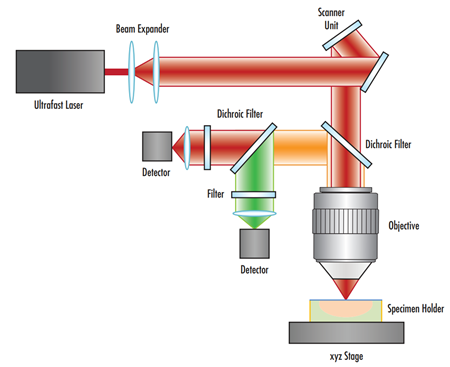Unique ultrafast laser part two
Dispersion and pulse spreading: Group delay dispersion
One of the most difficult technical challenges encountered when using ultrafast lasers is maintaining the duration of the ultra-short pulses initially emitted by the laser. Ultrafast pulses are very susceptible to time distortion, which makes the pulses longer. This effect gets worse as the duration of the initial pulse shortens. While ultrafast lasers can emit pulses with a duration of 50 seconds, they can be amplified in time by using mirrors and lenses to transmit the pulse to the target location, or even just transmit the pulse through air.
This time distortion is quantified using a measure called group delayed dispersion (GDD), also known as second-order dispersion. In fact, there are also higher-order dispersion terms that may affect the time distribution of ultrafart-laser pulses, but in practice, it is usually sufficient just to examine the effect of the GDD. GDD is a frequency-dependent value that is linearly proportional to the thickness of a given material. Transmission optics such as lens, window, and objective components typically have positive GDD values, which indicates that once compressed pulses can give the transmission optics a longer pulse duration than those emitted by laser systems. Components with lower frequencies (i.e., longer wavelengths) propagate faster than components with higher frequencies (i.e., shorter wavelengths). As the pulse passes through more and more matter, the wavelength in the pulse will continue to extend further and further in time. For shorter pulse durations, and therefore wider bandwidths, this effect is further exaggerated and can result in significant pulse time distortion.
Ultrafast laser applications
spectroscopy
Since the advent of ultrafast laser sources, spectroscopy has been one of their main application areas. By reducing the pulse duration to femtoseconds or even attoseconds, dynamic processes in physics, chemistry and biology that were historically impossible to observe can now be achieved. One of the key processes is atomic motion, and the observation of atomic motion has improved the scientific understanding of fundamental processes such as molecular vibration, molecular dissociation and energy transfer in photosynthetic proteins.
bioimaging
Peak-power ultrafast lasers support nonlinear processes and improve resolution for biological imaging, such as multi-photon microscopy. In a multi-photon system, in order to generate a nonlinear signal from a biological medium or fluorescent target, two photons must overlap in space and time. This nonlinear mechanism improves imaging resolution by significantly reducing background fluorescence signals that plague studies of single-photon processes. The simplified signal background is illustrated. The smaller excitation region of the multiphoton microscope also prevents phototoxicity and minimizes damage to the sample.

Figure 1: An example diagram of a beam path in a multi-photon microscope experiment
Laser material processing
Ultrafast laser sources have also revolutionized laser micromachining and material processing due to the unique way that ultrashort pulses interact with materials. As mentioned earlier, when discussing LDT, the ultrafast pulse duration is faster than the time scale of heat diffusion into the lattice of the material. Ultrafast lasers produce a much smaller heat-affected zone than nanosecond pulsed lasers, resulting in lower incision losses and more precise machining. This principle is also applicable to medical applications, where the increased precision of ultrafart-laser cutting helps reduce damage to surrounding tissue and improves the patient experience during laser surgery.
Attosecond pulses: the future of ultrafast lasers
As research continues to advance ultrafast lasers, new and improved light sources with shorter pulse durations are being developed. To gain insight into faster physical processes, many researchers are focusing on the generation of attosecond pulses – about 10-18 s in the extreme ultraviolet (XUV) wavelength range. Attosecond pulses allow the tracking of electron motion and improve our understanding of electronic structure and quantum mechanics. While the integration of XUV attosecond lasers into industrial processes has yet to make significant progress, ongoing research and advancements in the field will almost certainly push this technology out of the lab and into manufacturing, as has been the case with femtosecond and picosecond laser sources.
Post time: Jun-25-2024





